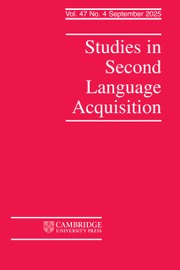Article contents
The Word Unit in Second Language Speech Production and Perception
Published online by Cambridge University Press: 07 November 2008
Abstract
The purpose of this study, which focused on the word taco as spoken in Spanish and English, was to explore the word as a unit in second language (L2) speech acquisition. As expected, acoustic measurements revealed that Spanish and English monolinguals' renditions of taco differed systematically. It was also shown that the extent to which Spanish/English bilinguals approximated English phonetic norms for any one segment of taco was correlated with their approximation for the other three segments, and that early learners differentiated Spanish versus English taco more than did late learners. It also appeared that the bilinguals produced /t/ with less English-like voice onset time (VOT) values in English taco than in other English words without a cognate in Spanish. In a perception experiment, listeners were able to identify the native language of Spanish and English monolinguals on the basis of their production of taco. The listeners heard larger differences between Spanish and English taco tokens spoken by early than late learners of English L2. Two additional perception experiments assessed further the phonetic dimensions that listeners use to determine language identity and to gauge bilinguals' speech production accuracy. Listeners assigned to language identification and goodness rating tasks responded to acoustic information distributed over all four segments in taco, although the VOT of the word-initial /t/ appeared to be the single most important phonetic dimension. Taken together, the results of this study suggest that (a) bilinguals' accuracy in producing the various segments of a second language word may be interrelated and (b) in judging L2 speech, listeners respond to phonetic errors distributed over the entire word.
Information
- Type
- Articles
- Information
- Copyright
- Copyright © Cambridge University Press 1994
References
REFERENCES
- 33
- Cited by

